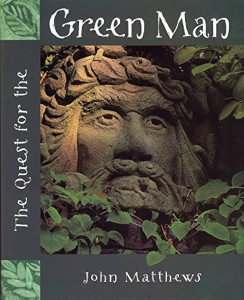 John Matthews’ The Quest for The Green Man is one of the many books we’ve gotten that touch upon the green man motif. It is typical of the many books that John and Catlin Matthews have produced — lavishly illustrated, clear, straightforward text, and chock full of useful information. Now go buy it! Oh, you want to know more about it? Grumble …
John Matthews’ The Quest for The Green Man is one of the many books we’ve gotten that touch upon the green man motif. It is typical of the many books that John and Catlin Matthews have produced — lavishly illustrated, clear, straightforward text, and chock full of useful information. Now go buy it! Oh, you want to know more about it? Grumble …
Oh, OK. Let’s start with who John is. He is a writer, lecturer and gifted storyteller with more than forty books to his credit. He has made a lifelong study of Celtic mythology and the Arthurian legends, about which he has written a number of works, including The Celtic Book of Days, The Grail, The Encyclopedia of Celtic Wisdom, and The Winter Solstice. Some of his books, such as Gawain, Knight of the Goddess, The Song of Taliesin and Robin Hood, Lord of The Greenwood, focus upon individual mythopoetic beings.
John, according to some sources, reads great quantities of speculative fiction and watches films and TV. His well-known love of both the Star Trek and Babylon 5 television series has recently led him to explore the myths that make up the backgrounds of these series.
The Winter Solstice: The Sacred Traditions of Christmas touched briefly upon one of the aspects of the green man, The Holly King, but The Quest for The Green Man is a far more detailed look at the topic. Be warned — Matthews is definitely interested in pressing an ecopolitical agenda that may offend those seeking a more ‘historical’ look at the green man and how he came to be. (Note that Lady Raglan coined that term in the beginning decades of this century.) John Matthews’ green man is not the foliate found on churches, taverns, and other buildings in England and parts of Europe. Rather, his green man is that of the Horned God motif that gave us Robin of Sherwood, the Oak King, the Holly King. The Wild Man, Herne the Hunter, and even the venerated Winter King.
Like many contemporary neo-pagans of an Anglo-Celtic bent, Matthews is attempting to create a history where possibly none exists. This is not the first time that neo-pagans have done this — the entire history of the horrifying event that is called The Burning Times, where hundreds of thousands of witches were murdered, has scant roots in reality.
OK, so why should you buy this? Because if you’re a neo-pagan (and I’m sure many of you are), you’ll love his thesis. Unlike the many books written on the green man that only detail the history of his existence in myriad forms, Matthews goes one step further by shining a light on the green man with a contemporary flair and thus making him more accessible to us today as a spiritual meme that has meaning in an environmentally degraded world. As Jethro Tull said in ‘Jack in the Green’:
Jack, do you never sleep —
does the green still run deep in your heart? Or will these changing times,
motorways, powerlines, keep us apart?
Well, I don’t think so —-
I saw some grass growing through the pavements today.
What you get is a mythopoetic approach that stresses strongly the spiritual and mythic aspects of the green man, as opposed to more art-based approaches of authors like Kathleen Bashford in her study, The Green Man or Anthony Hayward’s The Green Men of Birmingham. The latter two works will appeal to the more serious student of the green man as art, but this book will tell you far more about how the motif has been kept alive by everyone from morris dancers to villages with ages-old May Day celebrations to, yes, neo-pagans recreating the Lord and The Lady of the Forest.
Matthews covers everything you need to know about the green man, cast in a contemporary light. All neo-pagans who follow an Anglo-Celtic spiritual tradition should own a copy of this work. This book certainly will remain in the Green Man Review reference library!
(Quest Books, 2002)
